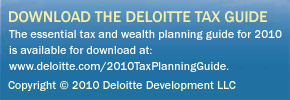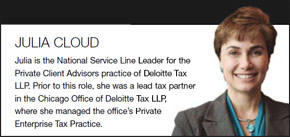|
As leaders in Washington have sought ways to improve the health
care system, shore up Medicare and social security, and reform
the tax code, increasing taxes on the wealthy has often led
the list of ways to raise revenue. Additionally, continuing
challenges in the economy mean that taxpayers, investors, and
private business owners have to think strategically about structuring
their assets.
To help individuals and private companies effectively navigate
today’s volatile landscape, Deloitte Tax LLP (Deloitte
Tax) has released a useful resource: ‘The essential tax
and wealth planning guide for 2010: a yearround resource for
navigating change in today’s economy.’
The guide focuses on areas where changes can be expected and
where taxpayers should look for opportunities to preserve the
value of their holdings and manage their tax liabilities. The
guide also stresses the need to plan throughout the year, despite
the lack of concrete information about the future.
As you consider your approach to the changing environment,
the guide’s four primary sections can help walk you through
the steps necessary to review your current situation and to
consider appropriate actions for protecting and building your
financial position.
Current environment
The guide begins by examining some of the forces that will require
changes in federal taxes and spending. Effective planning in
this environment demands that you develop your own personal
views on the economy and the markets, on the future of taxes
and tax rates, and on federal spending priorities that may influence
your financial and retirement needs.
Although no one can predict the future, you may want to test
your plans under a range of possibilities. In particular, the
guide highlights several areas that may affect high-net-income
individuals, including:
- individual tax rates
- estate and gift taxes
- taxation of partnership profits interests
The guide provides a high-level overview of the US political
climate and challenges that may shape the debates and developments
around these and other areas, as well as a general outlook for
tax reform.
Just one example is the passage of the Patient Protection and
Affordable Care Act, which includes a number of provisions targeting
high-income individuals. It is clear that Congress must soon
confront the expiration of the 2001 and 2003 tax cuts, as well
as reform related to corporate income taxes.
|
 |
But even if these waves of reform occur, Congress likely will
not have enough revenue to do all that is asked of the federal
government – forcing consideration of an additional federal
levy in the form of some kind of a consumption tax. The potentially
dramatic level of changes creates unparalleled uncertainty for
individual tax and wealth planning. It also can create opportunity
for those who address the uncertainty head on.
Accordingly, the Deloitte Tax guide offers three important
principles for planning in uncertain times:
- Continue to plan; work with what you know
- be aware of quick answers and simple advice
- watch for opportunities and know your risk
Income tax
Appropriately reducing or postponing the payment of federal,
state, and local income taxes is a critical component of assembling
the capital from which wealth grows. Although income taxes may
seem hopelessly complex, effective tax planning begins with:
- understanding and managing the alternative minimum tax
- using tax benifits accorded capital gains and qualified
dividends
- planning chartitable giving
- considering the impact of state taxes
- managing the benifits afforded by qulified retirement and
incentive compensation plans.
In addition to reviewing considerations and offering a variety
of planning tips related to these areas, this chapter also summarises
recently enacted income tax law changes affecting individuals
and reviews current tax rate structures.
Investments
Investors are faced with seemingly daily upheaval in the markets.
While it is natural and healthy to reexamine our fundamental
investment plans and take advantage of lessons learned, an investor’s
best defence is solid, up-front planning and effective investment
management. The guide reviews some fundamental activities that
can help you establish a sound approach to investment planning.
These steps include:
- articulating needs, goals, and preferences
- investing pursuant to an established asset allocation that
considers your risktolerance, time horizon, and personal goals
- considering the use of asset allocation techniques to enhance
the tax efficiency of your portfolio
- putting your investment plan in writing
- implementing your investment plan
- monitoring your preferences and holding your investment
managers accountable.
|
 |

Wealth transfer tax
Effective wealth transfer planning involves an ongoing process
that requires monitoring, updating, and making adjustments throughout
your lifetime as goals, objectives, and circumstances change
and evolve. The five major steps of the planning process are:
- defining your family wealth and charitable goals and objectives
- understanding the available wealth transfer tax exemptions,
exclusions, and transfer taxes
- reivesting and tuning your plans and goals as personal cirumstances,
and tax laws, change.
In addition to providing planning ideas to support these essential
planning stages, the guide reviews current rules and issues
related to gift, estate, and generation-skipping transfer taxes.
It also covers other contemporary matters such as Dynasty trusts,
charitable gifts, the role of insurance in wealth planning,
cross-border wealth considerations, and wealth planning in a
lowinterest- rate environment.
Other planning considerations
Finally, the guide includes a section examining key developments
and planning ideas relevant to private business owners, private
equity and hedge funds, and real estate investors, particularly
in the current economy. The guide also includes a section exploring
current incentives for individual taxpayers to go “green,”
including a number of provisions introduced as part of the American
Recovery and Reinvestment Act of 2009.


|










